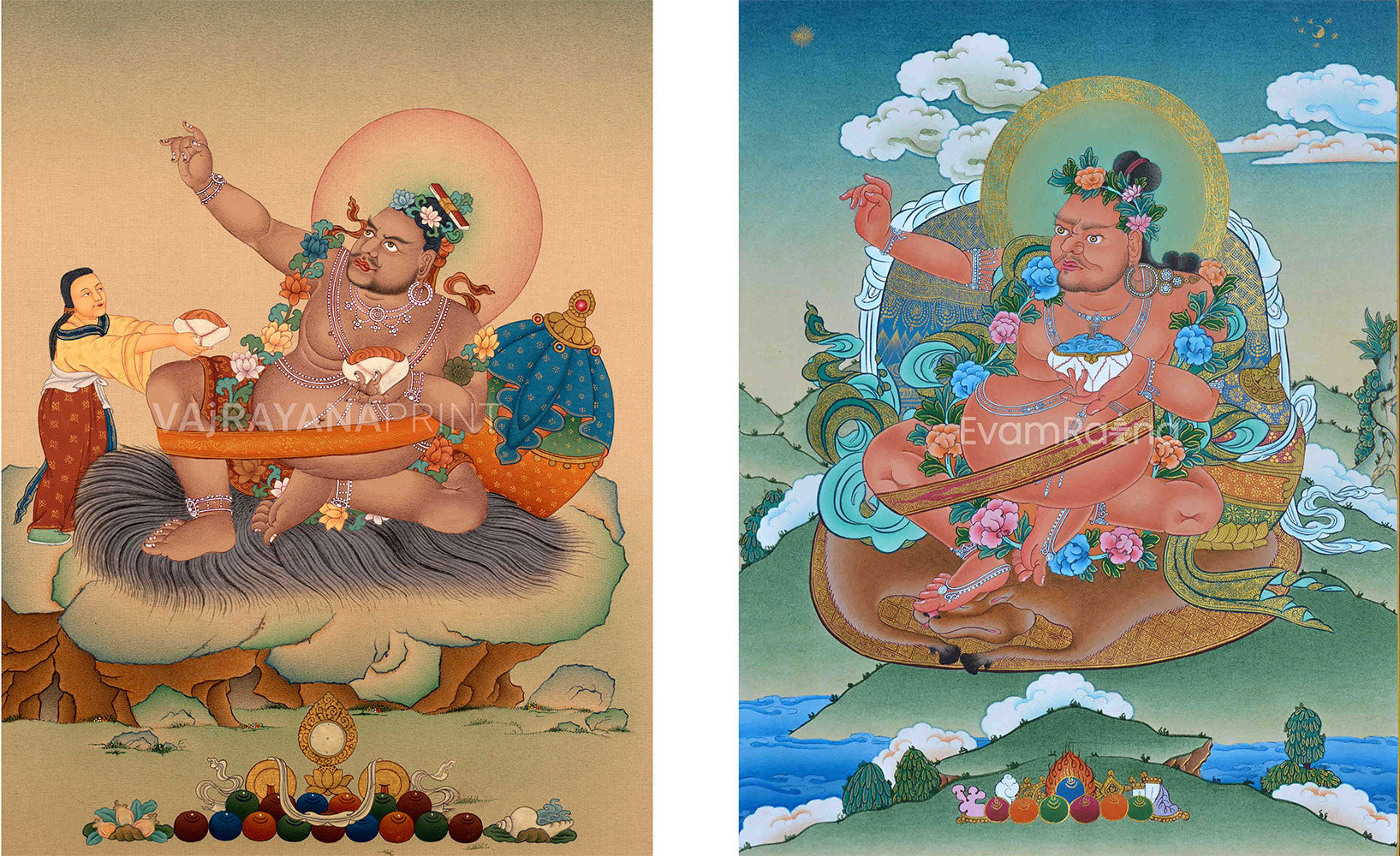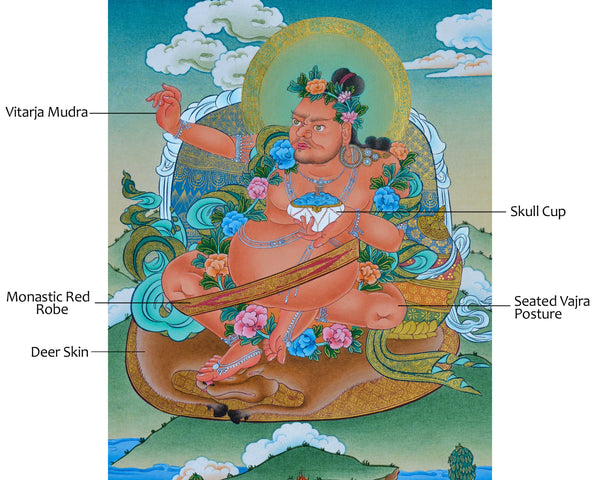Exploring the Mystical World of Mahasiddha Virupa
Few characters in the vast fabric of Buddhist philosophy and history are as fascinating and mysterious as Mahasiddha Virupa. This mythical mahasiddha, whose name translates to "Deformed" in Sanskrit, challenges ideas about morality, beauty, and spiritual development and is a testament to the transformational power of Buddhist practice.
The life and teachings of Virupa provide a glimpse into the esoteric practices of tantric Buddhism, exposing the unusual approaches and profound realizations that distinguish this route to nirvana.
Key Takeaways
- Virupa is a seminal Vajrayana Buddhism figure known for his unconventional methods and miraculous powers.
- His life story exemplifies that enlightenment is accessible to all, regardless of outward appearance or social standing.
- Virupa's teachings and legacy have impacted various Buddhist traditions, particularly the Sakya school of Tibetan Buddhism.
- Understanding Virupa's life and teachings can provide valuable insights into the nature of spiritual practice and the potential for transformation inherent in the Buddhist path.
The Life of Shri Virupa: Early Years and Renunciation

Although Virupa was raised in a royal family, he strongly preferred spiritual practice over worldly pursuits from a young age.
When he gave up his life as a prince and became a monk, committing himself to the study and practice of Buddhism, his path took a dramatic turn. He is known for his deep meditation, strict discipline, and steadfast pursuit of enlightenment at this time.
Transformation and Enlightenment
Following years of diligent effort, Virupa's spiritual journey took a significant turn when he attained a deep understanding that went beyond the traditional bounds of Buddhist philosophy.
This insight signified his development into a mahasiddha, a tremendous adept endowed with profound esoteric knowledge and superhuman abilities. Virupa's direct realization of reality's ultimate essence, unencumbered by the dualities that constrict ordinary awareness, is what defines his enlightenment.
| Notable Miracles | Symbolic Meaning |
| Stopping the sun | Mastery over time and illusion |
| Turning water into wine | Transformation o the mundane into the sacred |
| Teleportation | Transcendence of physical boundaries |
The Teachings of The Great Adept Virupa
- The Nature of Reality
The understanding of the ultimate essence of reality, which Virupa defined as existing outside the realm of ordinary observation and conceptual cognition, is at the core of his teachings.
He encouraged his followers to see past the outward manifestations of the world to the underlying emptiness and interconnection of all things, emphasizing the value of firsthand experience and realization.
- The Path of Tantra
Virupa is credited with creating and spreading tantric Buddhism, which accelerates the path to enlightenment by using symbolic ceremonies, mantras, and meditation techniques.
His teachings emphasize using the same forces that bind beings to the cycle of reincarnation as a method of achieving liberation—the transformation of negative emotions and cravings into wisdom and compassion.
- The Role of the Guru
Virupa believed the bond between a guru and a student was essential. According to his teachings, the guru is not just a teacher but also the physical manifestation of enlightened wisdom, and following their instruction is crucial for traversing the complex and sometimes dangerous road of tantric practice. This idea is shown by the deity's life, in which he guided many pupils to great realizations by acting as a spiritual mentor.
- Influence on Buddhist Traditions
Virupa's impact on Buddhism, particularly within the Vajrayana tradition, cannot be overstated. He is held in high esteem as a foundational figure in several lineages, including the Sakya school of Tibetan Buddhism, which views him as the first in a line of significant gurus. Buddhists all around the globe are still studying and using his teachings and techniques, which represent the essence of tantric spirituality.
Virupa Mantra
Virupa, one of the most illustrious mahasiddhas in the Vajrayana tradition, is associated with several practices and mantras that embody his profound spiritual realizations and siddhis (powers).
Although there isn't a single mantra that is referred to as "the mantra of Virupa" in the same way as specific mantras are associated with particular deities, his teachings frequently highlight the significance of sound, intention, and the transformational potential of tantric practices.
To illustrate his spiritual legacy, we will concentrate on a broad chant that captures the essence of tantric change for the sake of this study. It is vital to remember that some Virupa mantras can be discovered within specific lineages or practices and are usually taught directly by a competent teacher.
"OM AH HUM VAJRA GURU PADMA SIDDHI HUM"
- The holy syllable "OM" stands for the cosmos and ultimate reality in Buddhism, Hinduism, and other religions.
- AH: Often linked to openness and the dissolution of ego, this symbol represents the essence of pure consciousness.
- HUM Stands for the knowledge and compassion combined in the mind of enlightenment.
- VAJRA: This sign denotes unbreakability and clarity akin to a diamond; it symbolizes the lightning bolt of enlightenment.
- GURU: A spiritual mentor or instructor who represents the origin of all knowledge.
- PADMA: Meaning "lotus," this emblem denotes spiritual development and purity.
- SIDDHI: Alludes to spiritual accomplishments or abilities.
- HUM: Seals the mantra with the enlightened mind, reaffirming the union of knowledge and compassion.
Benefits of the Mantra:
- Transformation of Negative Emotions: Chanting this mantra can help cleanse and turn negative emotions into knowledge and compassion, much as Virupa transformed ordinary experiences into roads toward enlightenment.
- Spiritual Insight and Clarity: The mantra helps practitioners acquire insight into the nature of reality and their true nature by invoking the vajra's clarity and indestructibility.
- Blessings of the Guru: The guru principle allows practitioners to improve their progress toward enlightenment by receiving blessings and direction on their spiritual journey.
- Attainment of Siddhis: This mantra encourages the development of spiritual abilities or siddhis, that may be used in the service of others, even if the ultimate aim of the practice is enlightenment for the benefit of all creatures.
Physical Attributes of Virupa

The mahasiddha is often depicted with a robust and powerful physique, symbolizing his mastery of physical and spiritual realms. His physical appearance, including his facial expressions and postures, conveys his transcendence of ordinary human limitations and his embodiment of enlightened wisdom.
Facial Expression
- Depicted with a stern or wrathful expression
- Does not indicate anger but represents his determination to cut through ignorance and delusion
- Symbolizes the fierce compassion that motivates him to help sentient beings overcome their attachments and aversions
Piercing Gaze Eyes
- One of the most distinctive features which is often directed towards the sky or the horizon.
- Depiction is related to the legendary account of him stopping the sun in its tracks
- Upward gaze symbolizes his mastery over time and the elements and insight into reality's ultimate nature
Hair
- Typically shown as matted or tied up in a topknot, adorned with a crown or a skull tiara
- Reflects his ascetic lifestyle and his connection to the yogic and tantric traditions within Buddhism
- reflects his ascetic lifestyle and his connection to the yogic and tantric Traditions within Buddhism
Iconography of Virupa
The iconography surrounding Virupa is rich with symbols and objects that carry specific meanings within the Buddhist tradition. Each element of his depiction is carefully chosen to convey aspects of his teachings and spiritual attainments.
Holding a Bow and Arrow
- Symbolizes his ability to pierce through illusions and to target the truth directly
- Reflects his teachings on the nature of reality and the importance of direct realization.
Damaru & Bell
- Depicted holding a damaru (hand drum) in his right hand and a bell in his left
- Represents the creative aspect of the universe, while the bell symbolizes wisdom.
- They embody the union of wisdom and method, a central concept in tantric Buddhism
Alcoholic Beverage
- Shown with a cup of an alcoholic beverage,
- Which he famously used to perform miracles and teach lessons on the nature of emptiness and the transformation of mundane experiences into spiritual insights
- Challenges conventional moral judgments and illustrates the principle that enlightenment transcends ordinary dualities.
The Tale of Virupa and the Sun
In addition to being a highly esteemed mahasiddha in Buddhism, Shri Virupa was also well-known for his unconventional approaches to Dharma teaching. Among his life's most famous stories is about an event at a tavern.
According to legend, Virupa went into a tavern one day and started drinking. He consumed large amounts of beer without making any payments, even after finishing one or two pots. The bar owner demanded payment, getting irritated and suspicious of this supposedly hungry and penniless monk. Virupa provided an alternative form of payment as he had no intention of using traditional methods.
It was still the same day when he pointed his finger up at the sky, locking the sun in place to keep the day from becoming night.
The gods and humanity were distressed and confused because the sun stayed fixed in the sky, and the day did not end in darkness. Without the natural day and night cycle, crops could not develop correctly, upsetting the global equilibrium.
The gods approached Virupa after seeing the mayhem his acts had wrought and begged him to let the sun continue on its standard path. He consented, but only if the tavern owner would cancel his debt and the dharma would henceforth be open to everyone without regard to social standing or financial means.
He dropped his finger, his requirements satisfied, and the sun returned to its ordinary course. Through this deed, Virupa showed his compassion and dedication to the propagation of the dharma, in addition to his mastery over the elements and the illusory aspect of existence.
In the history of Buddhism, Virupa is a formidable character whose life and teachings never cease to uplift and challenge. His transformation from a royal prince to an enlightened mahasiddha exemplifies the path's transformational potential, providing direction and hope to everyone wishing to go beyond the bounds of everyday life.










